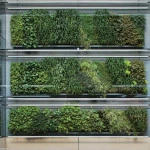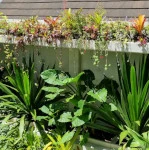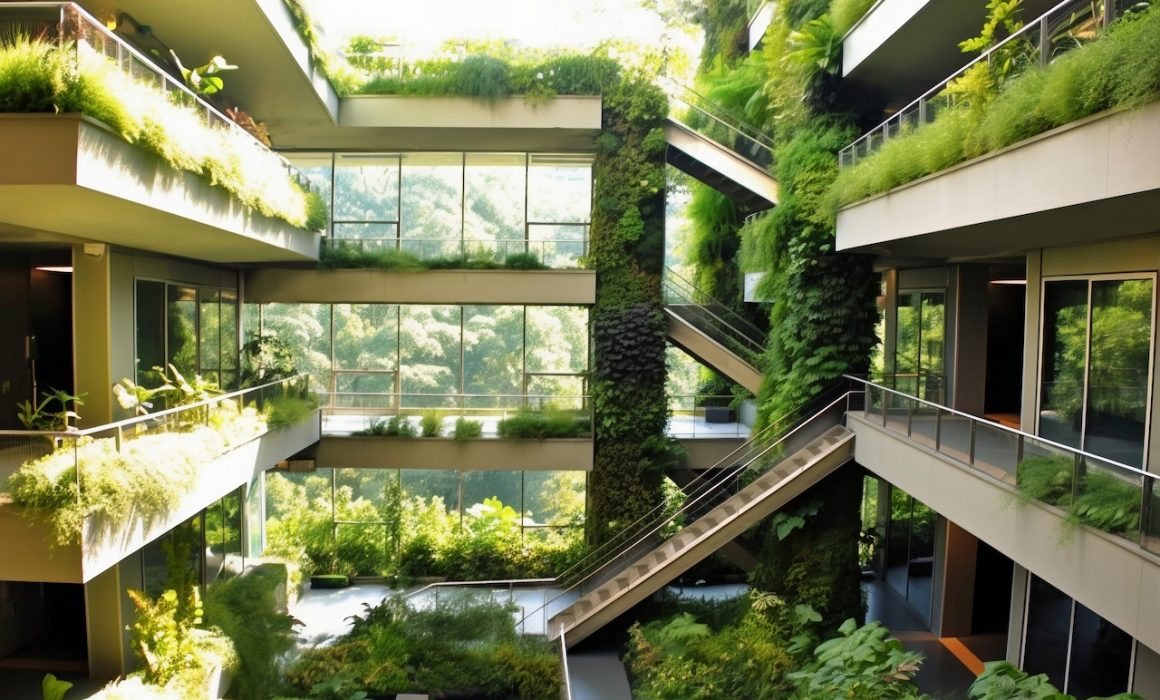Vertical Gardening: A Breath of Fresh Air for Urban Architecture
What if you could turn a bare wall or uninspiring building facade into a lush, living tapestry? Well, that’s the magic of vertical gardening. Vertical gardens bring nature into our urban lives, adding green to break up all that boring grey concrete and steel. Not to mention, vertical gardens are one key element to eco-friendly biophilic architecture, making for a harmonious blend of beauty and sustainability.
Today, we’ll cover what you need to know about vertical gardening.
What is vertical gardening?
Vertical gardening, also known as green walls or living walls, is a way to grow plants on a wall or structure that stands by itself. This method is great for cities where floorspace is hard to come by, and it can be done both inside and outside.
The flexibility of vertical gardening makes it a popular choice for adding a touch of nature to various settings, from city centres to cosy home interiors.
Where to use vertical gardening?
- Urban residential areas: In cities with limited space, vertical gardens can turn balconies, patios and walls into green spaces. Why not turn your home into a green sanctuary? You’ll enjoy a boost in mood and productivity thanks to an indoor vertical garden, which also improves air quality.
- Commercial buildings: Offices, hotels and retail spaces can use vertical gardens to liven up their exterior and interior environments, creating a welcoming atmosphere for clients and employees.
- Educational institutions: Schools and universities can incorporate vertical gardens as educational tools and promote green living among students.
- Healthcare facilities: Hospitals and clinics can use vertical gardens for their therapeutic benefits, creating calming and healing environments for patients and staff.
- Infrastructure: Vertical gardens can turn necessary infrastructure like carparks, bridges and transit stations into more naturally integrated, green spaces.
- Industrial sites: They can also be used at industrial sites like factories and warehouses to break up stagnant architecture and be more environmentally friendly.
If you want an alternative to vertical gardening, you can choose greenroofs for urban landscapes. Greenroofs are essentially gardens on rooftops. They’re not just visually appealing, they help manage rainwater, reduce heating costs, and provide additional green spaces in crowded cities.
Benefits of vertical gardening
In cities where horizontal space is scarce, vertical gardening can broaden the options for getting a bit of nature in. Vertical gardening is about growing plants up, not spreading them out. It’s like having a living painting; not only does it make a space more beautiful but it also cleans the air and if installed outdoors, gives birds and insects a place to live.
- Space-saving: They use vertical space instead of ground space, which is perfect for small areas.
- Improved biodiversity: The outdoor gardens help increase the variety of living things in cities by providing homes for birds, insects, and other wildlife.
- Thermal regulation: Vertical gardens act as natural insulation, helping to regulate building temperatures and reducing energy consumption for heating and cooling.
- Noise reduction: These gardens can also act as sound barriers, absorbing and deflecting urban noise pollution.
- Health and wellbeing benefits: Exposure to green spaces has been shown to reduce stress, and improve mood along with overall mental well-being.
- Community engagement: Vertical gardens can create a sense of community, especially in urban farming and communal garden projects.
- Economic benefits: By improving the aesthetic appeal of buildings and public spaces, vertical gardens can increase property values and attract tourism.
- Sustainable urban development: They are a key component in sustainable urban planning, contributing to eco-friendly urban designs.
How does vertical gardening improve the air?
Vertical gardening boosts air quality in many ways, making it a great eco-friendly choice, especially in cities where air pollution is a big concern.
- Air purification: With the correct light conditions, plants can take in carbon dioxide and give out oxygen. CO2 reduction in the office environment is key to reduction in sick building syndrome. Vertical gardens have a high density of plants without impacting space on the office floorplan. Meaning more plants in less space and purer air for everyone.
- Pollutant removal: The real magic is in the media that helps plants grow. Plants symbiotic relationship with the microbes in the growing media help soak up and clean out air pollutants like volatile organic compounds (VOCs), small particles, and other typical city pollutants. The large surface area of green walls allows more opportunity for pollutant capture than the small surface of soil in a regular pot plant.
- Dust reduction: Plants in vertical gardens can trap and absorb dust particles from the air. The leaves’ surfaces act as natural dust filters, capturing these particles, which are then washed away by rain or can be manually cleaned off, reducing the amount of dust in the air.
- Temperature regulation: Vertical gardens can help regulate temperature in their immediate vicinity. Plants release water vapour into the air through a process called transpiration. This natural process can help cool the air in urban areas, which are often subject to the heat island effect. Cooler air tends to hold less pollution, contributing to better air quality.
- Increased green space: In urban environments where space is limited, vertical gardens maximise greenery in a confined area. This expanded green space not only contributes to better air quality but also provides a habitat for biodiversity, further improving environmental quality.
Explore More with The Greenwall Company
With over 2,000 projects including green walls and roofs that are known for being light, varied and long-lasting, we’re ready to make your ideas a reality. Our green walls are made of 95% recycled materials, showing our dedication to environmentally-friendly and easy-to-maintain city greening.
Adopting vertical gardens in city landscapes is an eco-friendly way to green space, and bring nature back into our urban environments. Vertical gardening is not just a popular trend, it’s essential in our increasingly urban world. It’s a smart, green way to bring nature back into our everyday lives, make city spaces better, and help our cities be more comfortable and have cleaner air.
Discover how we can transform your space today.





